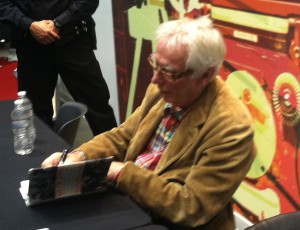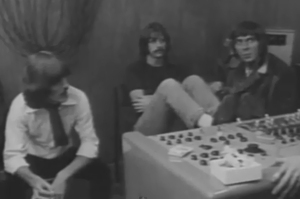For all the storylines and spectacle of the Beatles’ January 13, 1969, there’s even more detail that just didn’t fit into the 20,000 words I’ve already written about this single day. For context, Kafka’s The Metamorphosis checks in around 21,000 words, most about a bug yet not a single one about a Beatle. Here are some of the delicious leftovers from our Fab Four’s day:
***
It’s the opening theme to the second episode of Get Back:
“You’re my world, you’re my only love,” croons Ringo Starr as the credits roll.
This audio is displaced. In its original context served on the Nagra tapes, the moment comes a good hour after the documentary implies, happening when Ringo is exiting, not entering, the Twickenham Film Studios main stage on January 13, 1969, just before the drummer joins Paul McCartney in meeting John Lennon at the Twickenham canteen.
It’s not obvious what song Ringo’s singing. The vocal could be a misquote from Liverpool pal Cilla Black’s 1964 smash “You’re My World,” a four-week UK chart-topper that was ultimately knocked out of the top spot by Lefty Wilbury.
Years earlier, Ricky Nelson had a hit with “You’re My One and Only Love,” but that doesn’t seem like the inspiration, either.
It could just have been spontaneous on Ringo’s part.
There is another song he could be quoting more directly, though the source is a mystery. A clue could be in a hit song not by Ricky Nelson but Lefty’s brother Nelson Wilbury — Ringo’s bandmate George Harrison.
George’s “When We Was Fab” paid homage to life as a Beatle, but one line that fit unassumingly in 1987 stands out a little bit more as we revisit January 1969.
“You are my world, you are my only love”
Remember when around the same time, George pulled a largely unknown, decades-old B-side and album track from his memory and record collection and stuck it on his new album?
It sure seems there’s a missing link for “you’re my world, you’re my only love” — maybe it’s something the Beatles’ drunk uncles would sing at the pub in the Dingle or Speke in 1947 — a composition since lost to time that inspired callouts from both Ringo on January 13, 1969, and George, nearly 20 years later.
***
The near(er) future — more like 1974 — was tangible on January 13, 1969, too. Just ask Paul.
With two future members of Wings in the room at Twickenham Film Studios, a third was an occasional topic of conversation throughout the course of the day. Linda Eastman wasn’t a keyboardist yet, but Jimmy McCulloch, all of 15 years old and more than five years away from joining Wings, already earned status as a sharpshooter guitarist.

In flight: Jimmy McCulloch, Paul and Linda McCartney of Wings
McCulloch’s new band, formed by The Who mastermind Pete Townshend only a few weeks earlier, had barely started recording. Still, word certainly got around in the right circles in early 1969.
“[The Who’s manager] Chris Stamp told me that they’ve got a new group now … the guy (Andy Newman) that works in the GPO (General Post Office),” director Michael Lindsay-Hogg said. “What’s he called? Clapperbell or something. And they’ve got a guitar player who’s 14 [sic], who looks like he’s 6.”
“Plays like he’s 80,” Ringo retorted.
It wasn’t called Clapperbell, instead it was …
“Thunderclap Newman,” Paul said, hours later and out of the blue, in the closing moments of the day’s Nagra tapes.
“That’s the guitar player they’re telling me about who looks 6, who’s going to be 14,” Michael replied, excitedly.
They may have been formed by the Who’s leader, but Thunderclap Newman’s early biography tied closely to the Beatles, too. The group’s smash debut single “Something in the Air” – originally titled “Revolution” but renamed for obvious reasons – has the distinction of knocking “The Ballad of John and Yoko” from the toppermost of the poppermost in July 1969. The song later appeared on the soundtrack to The Magic Christian which, of course, starred Ringo and was co-headlined by Badfinger’s version of “Come and Get It,” as penned by Paul.
“Something in the Air” was recorded at Townshend’s home studio in Twickenham – precisely one mile from where the Beatles were presently gathered.
***
If it wasn’t enough to dream of future bands, the January 13 Nagras revealed pre-Beatles adventures, too.
On the heels of Linda’s relating a story of a horse stepping on her toes, Ringo described a more catastrophic injury suffered by his previous bandleader, Rory Storm.
“[He was] diving off New Brighton diving stage, going down and down, and he thought, where’s the water? And just as he decided to look up for the water, he slipped, and he broke his nose. So with a broken nose, blood everywhere, he ran right back up and dived off again.”
“He would, yeah, that’s Rory’s thing,” Paul chimed in before saying he recently ran into Rory “in the drive, washing his car.”
“He’s a swimming instructor when I saw him, and DJing, and trying to put a new group together. He’s great though, Rory, I like him. He’s a hustler.”
***
You’ll remember the sequence as comic relief in an otherwise sobering segment in Get Back.

A man delivering flowers to George seemed to be the last man standing who couldn’t recognize the absent Beatle. Doubled over laughing, Michael pulled himself together in time to ask Ringo if he liked the Hare Krishnas, who sent the gift.
“No, not really,” the drummer replied in perfect deadpan.
***
“Have you seen [that of] the top nine records in America, five are Motown?” Michael asked early in the day.
Music was always on everyone’s lips, even as the Beatles’ own production stalled.
“Penny Lane, I think, is one of the greatest songs I’ve heard in my whole life. You like it?” Michael asked later.
“Yes, but I don’t think it’s the greatest song I’ve ever listened to in my whole life,” Ringo replied in earshot of the song’s author.
Conceding how much Penny Lane “moved” him, Paul asked Michael if he was “from suburbia.”
MLH: No, it had to do with nostalgia for me.
Ringo: His father’s a fireman.
MLH: No, nor [worked at a] barbershop. But it’s about nostalgia, which always makes me break up and cry. That’s why Otis Blue is a very big [album] in my life.
We also learned a little trivia about the first records ever bought by some of our protagonists.
For Michael, it was “Quarter to Three” by Gary U.S. Bonds, while Glyn Johns’ first single was Lonnie Donegan’s “Rock Island Line.”
***
I mentioned this quote from Ringo in an earlier post somewhat in passing, but I thought it was interesting enough to call out again with greater surrounding detail.
With the time-limited Get Back sessions ongoing as filming for The Magic Christian loomed on the horizon, he was asked by Michael what he enjoyed more, drumming or acting. The answer revealed Ringo’s strong professional motivation. Someone give this guy a raise — and a little more vacation time.
“Well, it’s hard to say, doing so little movies and such a lot of the drums,” Ringo answered. “‘Help!’ and ‘A Hard Day’s Night’ was all right because its the four of us and we played, and did it. The only trouble with those [was] when I didn’t know what I was doing. … So I did ‘Candy‘, which was only two weeks — which was great because I have to do something.” (emphasis mine).
It wasn’t enough to be a father of two young children and drummer of the biggest band on earth and galaxies beyond. Ringo just had to work and eliminate extended down time. No wonder he got along so well with Paul.









